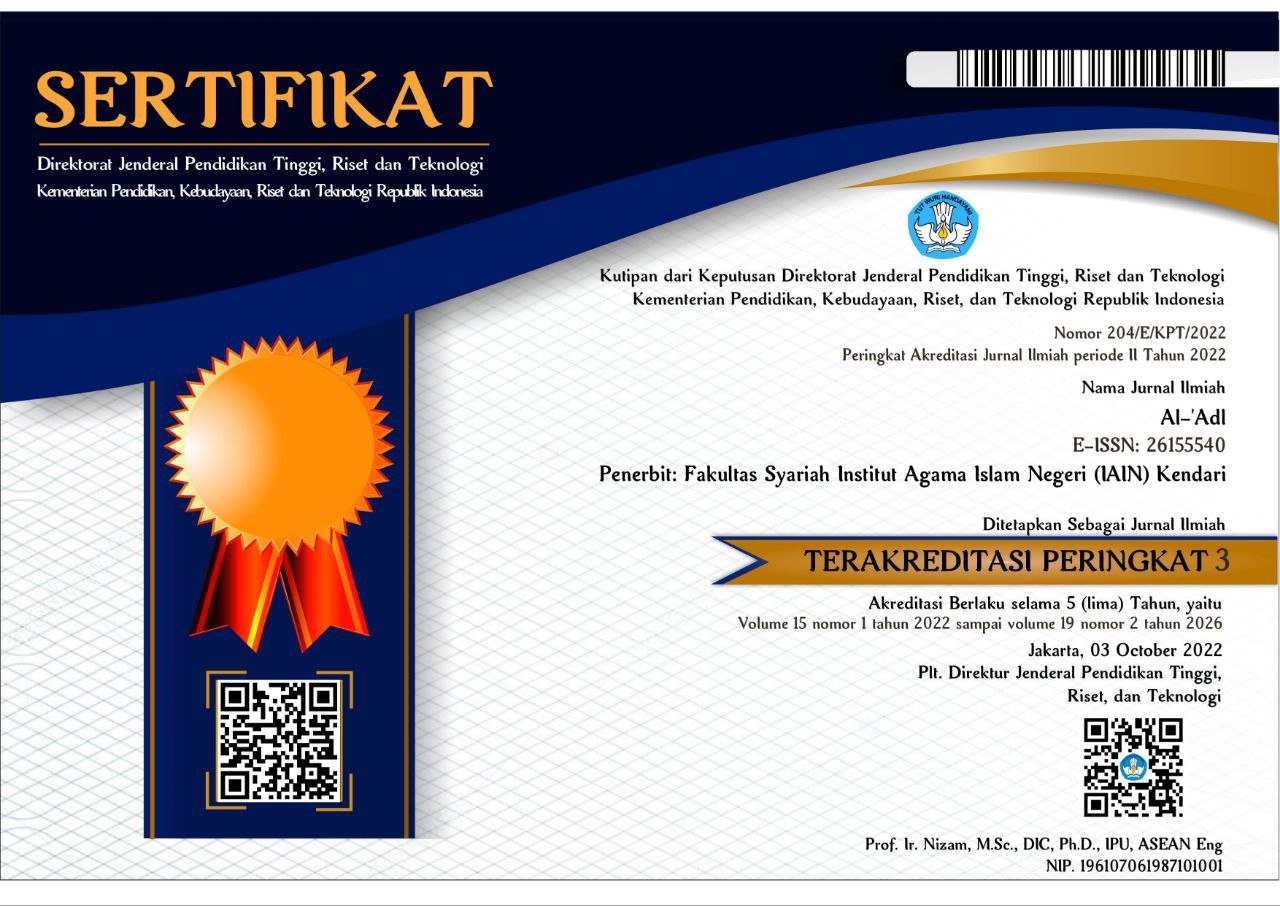Implications of The Revision of Law No. 16 of 2019 Againts the Practice of Child Marriage
Abstract
Keywords
Full Text:
PDFReferences
Ame, Kazi Rabeya. “Overcoming the curse of early marriage in Bangladesh.” Asian Journal of Women’s Studies 19.4 (2013): 150–163.
Arthur, Megan et al. “Child Marriage Laws around the World: Minimum Marriage Age, Legal Exceptions, and Gender Disparities.” Journal of Women, Politics and Policy 39.1 (2018): 51–74.
Azimi, Khadijeh. “The trend of girl child marriage in Iran based on national census data.” Sexual and Reproductive Health Matters 28.1 (2020): 1–4.
Bartels, Susan A., Saja Michael, and Annie Bunting. “Child Marriage among Syrian Refugees in Lebanon: At the Gendered Intersection of Poverty, Immigration, and Safety.” Journal of Immigrant and Refugee Studies 19.4 (2021): 472–487.
Bessa, Thais. “Informed powerlessness: child marriage interventions and Third World girlhood discourses.” Third World Quarterly 40.11 (2019): 1941–1956.
Ebetürk, Irem. "Global diffusion of laws: The case of a minimum age of marriage legislation, 1965–2015." European Journal of Cultural and Political Sociology 8.3 (2021): 294–328.
Fatma, Yulia. “Batasan Usia Perkawinan Dalam Hukum Keluarga Islam (Perbandingan Antar Negara Muslim: Turki, Pakistan, Maroko dan Indonesia).” JURIS (Jurnal Ilmiah Syariah) 18.2 (2019): 117.
Fitriyani, Abd.Basir. “Dispensasi Pernikahan Dini Pasca Revisi Undang-Undang Perkawinan di Indonesia.” Jurnal hukum 18.1 (2022): 36.
Gastón, Colleen Murray, Christina Misunas, and Claudia Cappa. “Child marriage among boys: a global overview of available data.” Vulnerable Children and Youth Studies 14.3 (2019): 219–228.
Gemignani, Regina, and Quentin Wodon. “Child Marriage and Faith Affiliation in Sub-Saharan Africa: Stylized Facts and Heterogeneity.” Review of Faith and International Affairs 13.3 (2015): 41–47.
Groepler, Nicolai, Johannes Huinink, and Timo Peter. “Does the birth of a child still prompt a marriage? A comparison of Austria, France, Germany and Hungary.” European Societies 23.3 (2021): 333–359.
Horii, Hoko. “A blind spot in international human rights framework: a space between tradition and modernity within the child marriage discourse.” International Journal of Human Rights 24.8 (2020): 1057–1079.
———. “Pluralistic legal system, pluralistic human rights?: teenage pregnancy, child marriage and legal institutions in Bali.” Journal of Legal Pluralism and Unofficial Law 51.3 (2019): 292–319.
Jayanti, Andi. “Perilaku pernikahan dini masyarakat di Kecamatan Onembute Kabupaten Konawe ditinjau dari theory of reasoned action.” Indonesian Journal of Education and Humanity 1.1 (2021): 54–62.
Kamaruddin, K, Andi Yaqub, and I Iswandi. “Paradoxical Implications of Article 7 Paragraph 1 of the Marriage Law in Indonesia.” Substantive Justice: International Journal of Law 4.2 (2021): 182–194.
Kurniawansyah, Heri, Ahmad Budi Kurniadi, and Muhammad Yamin. “Evaluasi Program Penyuluh Agama Islam Pada Kantor Urusan Agama Kecamatan Sumbawa Kabupaten Sumbawa.” Jurnal Kapita Selekta Administrasi Publik 3.1 (2022): 123–131.
McCleary-Sills, Jennifer et al. “Child Marriage: A Critical Barrier to Girls’ Schooling and Gender Equality in Education.” Review of Faith and International Affairs 13.3 (2015): 69–80.
Nur Falah, Muhammad, Aufi Imaduddin, and Kholisatul Ilmiyah. “Kenaikan Batas Usia Perkawinan Menurut Undang-Undang Nomor 16 Tahun 2019 dan Implikasinya Terhadap Kenaikan Angka Perkara Dispensasi Nikah di Pengadilan Agama Pemalang.” The Indonesian Journal of Islamic Law and Civil Law 1.2 (2020): 167–182.
Schaffnit, Susan B., Mark Urassa, and David W. Lawson. “‘Child marriage’ in context: exploring local attitudes towards early marriage in rural Tanzania.” Sexual and Reproductive Health Matters 27.1 (2019): 93–105.
Scolaro, Elisa et al. “Child Marriage Legislation in the Asia-Pacific Region.” Review of Faith and International Affairs 13.3 (2015): 23–31.
Wahi, Aditi et al. “The Lived Experience of Child Marriage in the United States.” Social Work in Public Health 34.3 (2019): 201–213.
DOI: http://dx.doi.org/10.31332/aladl.v16i1.4578
Refbacks
- There are currently no refbacks.
Copyright (c) 2023 SH .

This work is licensed under a Creative Commons Attribution 4.0 International License.








Organized by : Fakultas Syariah
Published by : Institut Agama Islam Negeri (IAIN) Kendari
Jl. Sultan Qaimuddin No. 17, Kec. Baruga, Kota Kendari, Provinsi Sulawesi Tenggara
phone. +62401-3193710
Fax. +62401-3193710
Email: [email protected]









